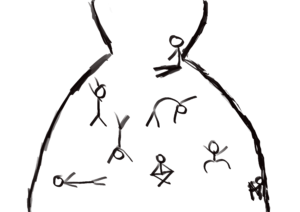Synchronizing is an advanced exercise for DID SystemWork. We need a certain level of communication and cooperation within the system, that we might not have at the very beginning. We will also struggle if we are still stuck in chronic dissociation because we need a form of mindfulness for this. If you want to avoid a more integrated life this exercise is not for you.
Structural dissociation
With structural dissociation we have the curious experience that parts of us can do vastly different things inside all at the same time. A moment when we might notice this the most is when one tries to sleep while someone inside is throwing a ball against a wall, someone else wants to go to a party and the third cries and wants to go home. Even without us noticing it, this is a constant state of our mind if we don’t make a conscious effort to act otherwise.

‘normal’ state
How to synchronize
When we synchronize each part takes their awareness and we focus it on the same activity at the same time. Ideally we will all connect with the body performing a certain action.
The most basic way to do this is breathing together.
That can easily be uncomfortable for some parts because they still don’t know that the body is safe now. So there might be some who can focus on the belly moving or the chest expanding, others might notice the shoulders lifting or how warm the air is at our nostrils. Some might not want to be in the body with their awareness, but they could still join the exercise by using the mind and counting breaths or giving the commands ‘inhale-exhale’ throughout the exercise or by using an imagery like the feather or a balloon moving in the same rhythm the collective system breathes in. Those are valid ways of joining too.
When breathing sucks
Breathing is the most basic thing we can do with our body and using it can support relaxation exercises, but for some it causes struggles to experience stillness with the body because it reminds of forced immobility during abuse. We might not be able to stop our body from entering hyperarousal when we try to sit still and just breathe. Then it is best to choose a different activity and not force yourself to do something you are not ready for. Walking can work well, so can peeling potatoes, knitting or scrubbing bathroom tiles. Try to find a simple activity that has an element of rhythm to it to make it easier for everyone to join in. Shared rhythm is what you are looking for. Almost like everyone inside is dancing to the same music, moving as one.

silly picture
The goal is not to do anything perfectly, it is to join in doing the same thing as best we can.
It takes practice. And every day will be different, so it is not like you will learn how to do it and then be really good at it. Especially on difficult days it might not work at all. We treat this like we treat meditation or yoga. Showing up is all that counts. The practice itself is the goal. It is already doing what it is supposed to do if we just try our best that day.
Negotiating synchronization
Some parts might not be motivated to join the exercise or be scared of it. Then it would make sense to negotiate a minimum participation. We keep all our sync exercises down to no more than 5 minutes. Some parts agreed to join in for as little as one breath cycle. But that is something and gives them the chance to make a safe experience and maybe we can re-negotiate some day. We always set an alarm to make sure we stick to our agreements.
Because we already have everyones attention we usually follow up with a roll call and then everyone can withdraw again if they want. Making this part of a morning/self-are routine helps not to forget it.
[If you have an engineered system (RA/MC) you might run into serious trouble if you even attempt to have parts do anything but what they are assigned to do and please don’t try to push anything and get yourself into danger. Like so often your path will probably look different from that of others with DID]
Why to synchronize
Energy
We have talked about mental economy and how to save energy to be able to invest it into big things like trauma work. Structural dissociation costs us a lot of energy. We don’t have to integrate fully to get some relief from the constant drain. When we all pay attention to the same thing and move as one it already saves an unexpectedly big amount of energy. Even just our 5 minute practice every day makes a significant difference in our overall energy levels.
That is also the reason why I advise you to actually focus on the body and a grounded experience in the real world. You might think that moving as one in the Inner World would do, but the Inner World is basically a structure made of dissociation. Its mere existence burns energy. The more we do things only in the Inner World the more energy is burned. For an energy-saving life we need to get used to be more connected to the body and the real world and live more in the front (co-conscious) and less in the back.
That is a basic principle that tells us about an ideal. Overcoming the phobia of the body and the present and of being grounded is part of healing. In reality, we just do the best we can and every system has to figure out for themselves if and how they can make it work. Not everyone needs to save energy.
Relaxation
The main reason why we even started synchronizing was to support relaxation. Even with the host doing relaxation exercises with the body our nervous system didn’t calm down.
We had simple measures (RSA) taken that showed that we were not entering a restorative activation of the PNS-VVC (aka ‘Bob’ – read about the polyvagal theory for detailed information why this matters) even with as much relaxation as was possible for the host. We tried again with as many parts as possible synchronizing and the measures got significantly better. The moment someone inside did something else they got worse again. This is actually the scientific reason why synchronizing feels so restorative. We are literally giving our body a break from high stress by allowing our nervous system to calm down. It makes a measurable difference. All our efforts in relaxation can be improved tremendously if we add the element of synchronization.
If you use things like autogenic training all parts could repeat the calming sentences together. With PMR you could focus on body parts together. You get the idea.
Our Littles were in love with sync exercises from the first minute and want to do them all the time, because relaxing with the body feels really really good.
Integration
Synchronizing will not lead to spontaneous fusion, but it can help us on our path to being more integrated. When we practice doing something together regularly it starts to seep into our everyday life after a while. We might develop the habit to draw closer together or to join the one who is front through co-consciousness. The dissociative barriers get lowered with time. This is a side effect you should be prepared for. If you don’t want to be more integrated, don’t do this exercise.
We can take synchronizing a step further and use it as a bridge to blending exercises. To do that we can join in an action we perform together, everyone paying attention to a different detail of it, and then try to share our experiences with each other to create one big felt experience of the moment. This takes practice too but the results can be utterly reviving. It can give us a moment of having a full, not-dissociated experience of being in the body and alive. It is impossible to describe, but to us it is like finally being completely real in a real world and it is pretty much the best feeling we ever had and like nothing we have ever known before.
Blending is pretty advanced, especially when several parts try to do it at once. So maybe this will be an idea to keep in mind for the future. You can ask your T about it for help.
Controlled dissociation
A regular practice of synchronization will bring us closer together. If we haven’t worked through our trauma yet, it is too early to move too far into integration. There is a reason why integration is phase 3 after trauma work. We will just be flooded with the memory of other parts when we get too close. That is why we always need to practice raising dissociative barriers when we practice synchronization that lowers them. The goal for now is to get control over the dissociative barriers, move them as we like and how it is useful for the situation, not to remove them entirely. There are times when it is not helpful to have Littles constantly co-conscious.
It usually takes a while until synchronizing moves us towards being more integrated and when we notice this shift inside it is time to start practicing our walls too. It will make us really flexible to react to the situation in the best possible way for as long as our structural dissociation is still needed.
Synchronizing is one of the few real ‘exercises’ that can be taught in DID therapy. So much of what we do depends on the interaction with the therapist or belongs to the standard tools for trauma treatment. This is different. It is powerful. And it changes things long-term. It is also not easy. We practice it every single day because it is the exercise that makes the biggest difference since we learned about containment. I hope it can help you too.


Leave a Reply